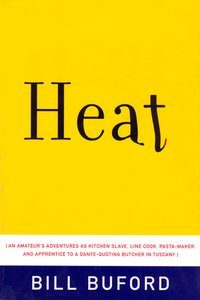Heat, Bill Buford
Doubleday Canada, 2006, 318 pages, C$32.95 hc, ISBN 0-385-66256-4
Given the way food expertise is being adopted as a hobby by an increasing number of people, Bill Buford’s odyssey in Heat doesn’t seem even remotely strange: Is it possible for enthusiastic home cook in his mid-forties to make the leap into the fast-paced world of professional cooking? Can an amateur learn the ropes and end up preparing food at a world-class three-star restaurant?
Of course, Buford has advantages that most enthusiastic mid-career home cooks can’t hope for: a home base in New York, a friendship with celebrity chef Mario Batali and enough money saved away to afford apprenticing at Batali’s Babbo restaurant. But even considering those advantages, his odyssey in going to the other side of the food world remains remarkable: What began as a profile of Batali for the New Yorker ended up a two-year odyssey in the world of cooking, pasta and butchery as Buford went from line cook to apprentice pasta-maker and butcher in Italy
So, how do you go from writing about a chef to butchering animals in Italy? It’s a gradual process. Buford starts out as an enthusiastic civilian chef –one prone to giving invitation to dinner parties, then keeping guests waiting as he races to get everything done. At some point, outsized personality chef Mario Batali ends up as a guest and Buford eventually musters up the courage to ask for a spot in Babbo’s kitchen, as an apprentice. Just to see if he could.
Cooking is a tough young man’s game, and for forty-something Buford, his apprenticeship is brutal. Not that he picked an easy assignment: Like most New York restaurants, Babbo is small, overheated and boiling from the pressure of the place’s reputation. Buford ends up working with a colourful cast of sharp-tongued tough kitchen professionals, and they don’t take it kindly to see an intruder in their domain. Buford starts at the lowest of the low, and though hard work eventually manages to get what he wants: some experience as a cook in a demanding professional environment –and some real scars to show the experience.) Heat never works better than during this first third, as we get to discover the inner working of a restaurant from the perspective of a well-informed civilian. Buford never becomes a distinguished member of the crew, but he runs with them long enough to make it a memorable narrative.
But the ever-curious Buford soon becomes obsessed with other culinary goals. To really learn about pasta, he decides to go get another apprenticeship, this time in Italy. Later, he gets fascinated with meat and gets another Italian apprenticeship, this time as a butcher’s assistant. (One of the book’s highlight described how Buford, trying to show what he has learned, drags an entire dead pig in his New York brownstone for butchering and cooking.) By the closing pages of the volume, he muses about French food and possibly sets up a sequel.
This European journey is where Heat cools off a bit: While it’s wonderfully picturesque and rustic, it also appeals to different impulses than the description of working in a high-pressure professional environment: It’s about food history, European traditions and a return to basics –not exactly what the first section of the book delivers. It’s still a pretty good read, mind you: Buford’s style is fun and accessible, while his discoveries pile up. But it feels like a let-down after the exceptional New York-based section.
Still, there’s a lot to like in the book even with a lacklustre second half. The portraits of celebrity chefs Mario Batali and Marco Pierre White are striking, the depiction of being “hammered” while working in a kitchen are vivid, there’s a hilarious passage about catering to chefs’ whims and there’s enough culinary tidbits (about short ribs, about tortellini, about polenta) to make the entire thing worthwhile for food-trivia hounds. The quasi-instinctive knowledge of food (say, when meat is done) that Buford eventually gets is the kind of practical expertise that can’t be faked.
As a food book, it may not have the insider’s authenticity of, say, Bourdain’s Kitchen Confidential. But in some ways, it’s likely to be closer to the reader’s experiences and idle musings, especially when they seriously get home cooking and start wondering if they, too, could turn it into something better. Marry that impulse to find out with a near-infinite appetite for knowledge, and you end up with Buford’s self-developing narrative. By the time Heat ends, Buford knows enough about food to stump experts; and readers know enough to be grateful for the journey.
